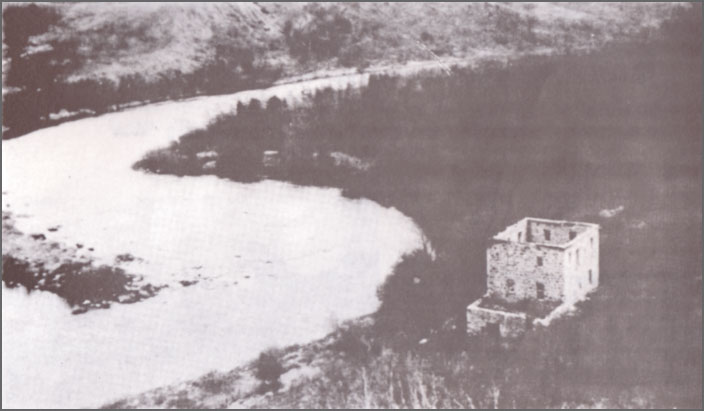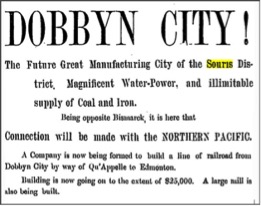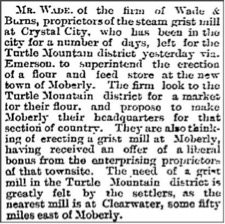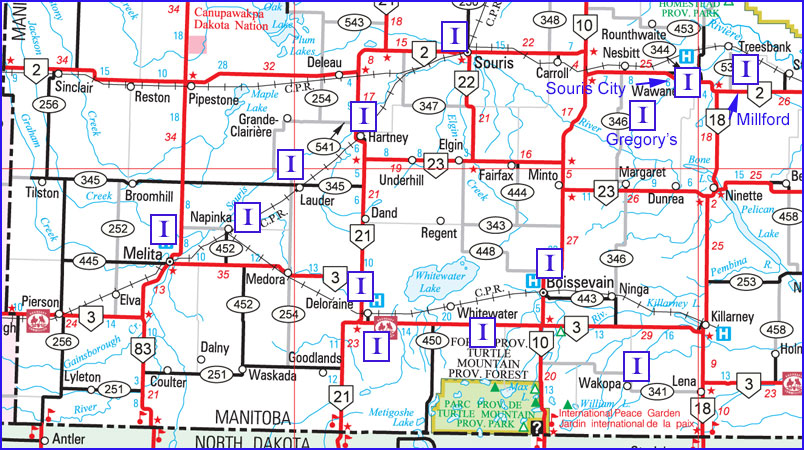 |

|
 |
Flour Mills
| Introduction First… a word from wikipedia… A gristmill (also: grist mill, corn mill, flour mill, feed mill or feedmill) grinds cereal grain into flour and middlings. The term can refer to either the grinding mechanism or the building that holds it. Grist is grain that has been separated from its chaff in preparation for grinding. We will use the terms gristmill, grist mill and flour mill interchangeably because al three are used in the source material. The European settlement of Southwestern Manitoba followed a process that had already been established elsewhere, across North America. People were here before services, before roads, before stores and towns They really were starting from scratch. Slow transportation and long distances made self-sufficiency a must. They came to farm, and they already knew that wheat and other grains were to be the primary crops. The prairies were opened to agricultural settlement for one main purpose – to grow wheat. The problem with that was that it was so far to market that there was little profit to be made. That was okay, they all knew that. Eventually rail lines would cross the land and everything would fall into place. In the meantime, subsistence was a starting point. Having a gristmill nearby, where one could at least exchange wheat for flour was a crucial advantage in making a homestead sustainable until a railway would arrive. Turning wheat into flour represented Manitoba's first step in becoming an industrialized society. Flour milling was practised by the province's aboriginal peoples long before Lord Selkirk's settlers engaged in the activity. When Manitoba gained provincial status in 1870, most flour mills were concentrated in the vicinity of the rapidly emerging city of Winnipeg. Flour mills supplied flour for the practical consumer needs of the district residents. The early mills operated on the millstone process, utilizing wind and water as a power source, with steam power being introduced around the time Manitoba became a province. The development of the gradual reduction process, using chilled iron rollers, revolutionized the milling industry in the world and in Manitoba. By 1890, a roller-process flour mill was considered an essential asset for the continued growth of every community, serving as a tangible symbol of new-found prosperity and progress. To increase their chances of becoming the service centre for their district, many villages and towns offered bonuses to millers to establish plants in their locale. A Trip to Gregory’s Mill This excerpt from a letter to the Manitoba Review by Cartwright pioneer, A.E. Steel, takes to back to those days. Our first grist of wheat was taken to the flour mill at Glenora and a farmer got his own wheat ground into flour and got all the flour, bran and shorts that he owned. After that we went to Wakopa flour mill owned by Harrision Bros., and again I havemade a number of trips to the Souris mill. The mill was equipped with the Hungarian Patent process and made an excellent grade of flour. Each round trip took four long days to go and return with oxen. The mill was kept running day and night, and if we were fortunate our gristing was done right away and we would be able to start for home without losing any time. The mill was owned by a man by the name of Gregory, and anyone that had to stay overnight was accommodated at his house. He had plenty of stable room and feed for the teams and the charge for man and beast was very reasonable. I remember Bob Blackwell and myself going with our grists to the Souris mill with the oxen and wagon after the freeze-up. The weather was lovely so we travelled until quite late the first day and then camped out for the night. We had plenty of with which to keep us warm. The next morning we hitched up early and got to Dunlop's for breakfast. (The town, Dunrea, is situated on that place now, or at least part of it). The townsite is on part of two farms that were owned by Dunlop and Ray so the town was named after the two farmers. Leaving Dunlop's, we entered Lang's Valley and travelled it for a few miles, then crossed up the other side and the next valley we entered was the Souris and then on across the river to the mill. This time there were a lot of grists ahead of us and that meant staying at the mill two nights instead of one. We could get our meals at the house but there wasn't sleeping accom- modation for all, so a number of us slept at the mill above the engine room which was nice and warm.  Gregory’s Mill – along the Souris River between Margaret & Wawanesa We got loaded up and started for home before daylight on Saturday morning and travelled a good distance be- fore we stopped to feed our teams. After giving them a good feed we got going again. Bob said he intended to stay that night at a friend's and he would not resume the journey until Monday morning, but I decided to go on home after feeding and resting the oxen. I passed through the north end of Killarney late at night, and after a while began to feel sleepy so I wrapped a quilt about me and lay between the bags. I knew the oxen would keep to the trail so I dropped off to sleep. I don't know how long I slept, but when I awoke, I found the oxen both laying down. I got them going again and finally reached home before daylight on Sunday morning. *Cartwright & District History Committee, Memories Along the Badger Revisited, 1985 p4 The First Mills In a sense the early mills were services that hoped to become towns. Places like Wakopa, Old Deloraine, and Plum Creek had mills very early, some time before the railway. With the coming of the railway links we saw the creation of more lasting towns. These towns wanted a gristmill and would often offer what was called a Mill Bonus to attract such a business. Interestingly the second wave of railway town, those on the second and third branch lines, like Waskada, Medora and Minto didn’t have establish flour mills, or many other industries for that matter. The first wave of town had those services and more. Some flout mills in the larger towns had already closed. There was no need. The period from 1881 and 1882, known as the “Manitoba Boom”, saw intense speculation in land sale – especially in town lots. Everyone knew that the population of rural western Manitoba was going to explode. Towns would be built, businesses established, and money would be made. The problem was that nobody was sure where all these new towns would be located. It all depended on where the railway lines would run, and where the railway company would decide to put a station. Although some railway surveys had been undertaken and some lines had been planned, no one knew where the stations would be. So some enterprising landowners decided that a piece of land they owned might just be a good spot for a town. Speculating in town lots was a bit like participating in a gold rush. You stake a claim and hope it pays. Exaggerations and outright lies were the tools of that trade. To sell the lots the promoter had to assure prospective buyers that the rail line was a sure thing. Another selling point was having a mill.  Winnipeg Times, March 9, 1882 The claims made in the following story could easily have been set to rest by checking with any local resident.  Winnipeg Daily Sun, Dec 23, 1881 There never was a building of any sort at Moberly, and the “nearest Mill” was indeed much closer than Clearwater. The mill at Wakopa in fact, had been up and running for some time. Flour Mill Locations  Pre- Railway Sites In 1878 Matthew Harrison built a flour mill in the settlement that would soon become Wakopa.This historic industry was the first in Turtle Mountain municipality. To accommodate the settlers who brought their wheat from afar by oxen to be ground into flour, the family built a boarding house and large livery barn. Later the Harrisons built a gristmill at Holmfield that would serve the area for over a century. On the second floor of that historic building one can still see the rough cut 2 by 6’s that were sawn at the old Wakopa for the Harrison’s next enterprise. Millford The town northeast of Wawanesa, was the brainchild of a Major R.Z. Rogers from Grafton, Ontario. In 1881, His gristmill, which was once described as a “small portable” one, was up and running, and farmers were hauling their grain to him. Souris City At its birth, Souris City, just south of Wawanesa, was one of many speculative “cities” that came with the Manitoba Land Boom of 1881-82. The gristmill, which was steam powered, was located along the river on the east side of the flats. Waubeesh Another casualty of the Manitoba Boom was the settlement of Waubeesh, west of Boissevain. A gristmill, whose wheel was to be turned by the water from Waubeesh Creek, was built by Robert John Hurt, and a huge celebration was held at its completion. Local histories tell us that, for unknown reasons the mill never ground a kernel of grain. Gregory’s Mill John Gregory’s built a mill on the Souris River about 12 kilometres south if Wawanesa in 1883. It was the most important mill south of the Souris River for over a decade. Fortunately, enough evidence of the site remains for one to visualize the whole operation. And we have a few photos. Plum Creek and Souris In 1880 William Henry Sowden, Thomas Gillespie Kells and John Nesbitt Kirchhoffer, members of the Millbrook Colonization Syndicate, acquired the property on Plum Creek near where it enters the Souris River. They did this because of its suitability for a mill site. The mill would justify the establishment of a settlement at what is now the Town of Souris. Old Deloraine In 1880, when the government decided to place a Land Titles Office along the Boundary Commission Trail in the Turtle Mountain district, it put the new village of Deloraine on the map. In November 1882 brothers William and Thomas Sheppard built one along Turtlehead Creek adjacent to the new and growing village. Railway Towns Boissevain In 1889 Preston and McKay built a substantial structure of local sandstone on the west side of Mill Road just south of the CPR track. In 1902, when the operation was consumed by fire there was no hesitation. By May of 1905 the Turtle Mountain Milling Co. Ltd., a consortium of local businessmen, had purchased the site and was beginning to erect a new building. Melita The establishment of the Melita Mill was voted on December 17, 1891, and first annual meeting of the Melita Milling Co. was held on January 26, 1892. The building was 36' x 48' in size and was four stories high. The engine house, also 36' x 48' was a solid structure to be lighted with electricity and fitted with all modern conveniences. Deloraine When Old Deloraine’s buildings were moved to the railhead, it was proposed to move Sheppard’s mill as well. The lack of an adequate water supply there, however, made this plan unfeasible. A new mill was built by the Ontario Milling Company in 1897. Hartney Hammond and Leckie, who operated a successful lumber yard and grain elevator in Hartney, entered the flour milling business. A substantial structure was erected, machinery installed and by 1894 it was in full operation. Coal from Estevan and water drawn by tank from the river, provided the steampower. Napinka In 1892 the booming town of Napinka offered a $5000 bonus to start a mill. Someone took the offer, built the mill then skipped town. (Sun April 26, 1975) Lauder May of 1892 a meeting of ratepayers took place to vote on the issue of bonds to raise money to assist the establishment of a mill. In 1893 an agreement was signed between the Municipality of Winchester and Giddens and Campbell of the London Engine Supply Company. This agreement called for a fifty-barrel mill that was to run full time and be operational by September 15, 1893. Conclusions The establishment of the rural milling industry was a direct result of the confidence demonstrated by those entrepreneurs and farmers who invested their fortunes, toil, and tears in the development of the province’s agricultural resources. The conversion of wheat into flour for practical consumer purposes provided evidence to investors that the region was worthy of future development. The agricultural sector provided the engine for the growth of the entire province. Four milling played an important role in this achievement. Even though many settlers had milling experience, and there was a definite need for the service, they weren’t prepared for the seasonal nature of prairie rivers and soon learned that water power wasn’t reliably available. Thus it was more costly here than in the east, and making a profit was more difficult. The decline and extinction of small independent flour mills across Manitoba can be largely attributed to the uncompetitive position in which these mills were placed by the large milling companies after the first World War. Consumers of flour gravitated toward the more inexpensive product produced by the large mills. Lack of business suffocated the independent millers and most were driven out of the business. The large milling concerns could not only undercut the price of flour that independent millers offered, but they operated at a distinct advantage because of their large reserves of capital. The large mills also had greater funds at their disposal for advertising. Over the course of the twentieth century, Manitoba’s rural population base began to decline; rural residents migrated to urban centres. All these factors played a part. Although the flour milling industry in rural Manitoba faced its perhaps inevitable decline, the role it played in that short period of transition to an agriculture based economy was both important and interesting. |
 |

|
 |